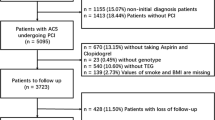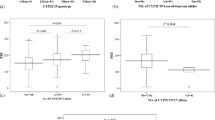Abstract
Clopidogrel is used in patients with coronary syndromes and at risk of thrombotic events or receiving percutaneous coronary intervention (PCI) for reducing heart attack and stroke. Here we present genotype and phenotype study of Iranian patients undergoing PCI treated with clopidogrel during a 6-month period of follow-up; common variants of CYP2C19, CYP3A5, CYP3A4, and ABCB1 genes were determined as well as the patients’ cardiovascular outcomes to find out the effect of these variants individually and in combination. 388 individuals receiving PCI were enrolled in this study. Different pretreatment doses of clopidogrel were prescribed under the interventional cardiologists’ guidance. The patients were followed for a duration of 1 month, and 6 months. Six SNPs were selected for genotyping including CYP2C19*2 (c.681G > A), CYP2C19*3 (c.636G > A), CYP2C19*17 allele (c.−806C > T), ABCB1 (c.3435C > T), CYP3A5 (c.6986A > G), and CYP3A4 (c.1026 + 12G > A). The mean loading dose was 600 mg/day in 267 (68.8%) individuals, 300 mg/day in 121 (31.2%). 8 patients had cardiovascular events such as thrombosis, unstable angina, and non-STEMI. The studied alleles and genotypes were in Hardy–Weinberg equilibrium. None of the SNPs individually were significantly associated with outcome events. Our results indicate that combinations of different alleles of genes are involved in pharmacokinetic variability and joint factors are important; this means that genotyping and analysis of an individual variant may not be as straightforward in risk assessment and pharmacogenetics. This highlights the importance of personalized medicine in risk assessment and treatment.

Similar content being viewed by others
Change history
09 August 2018
The original version of this article unfortunately contained a typo in the co-author name.
References
Rabbani, B., Nakaoka, H., Akhondzadeh, S., Tekin, M., & Mahdieh, N. (2016). Next generation sequencing: Implications in personalized medicine and pharmacogenomics. Molecular BioSystems, 12, 1818–1830.
Gros, P., Ben Neriah, Y. B., Croop, J. M., & Housman, D. E. (1986). Isolation and expression of a complementary DNA that confers multidrug resistance. Nature, 323, 728–731.
Cattaneo, M. (2011). The platelet P2Y(1)(2) receptor for adenosine diphosphate: Congenital and drug-induced defects. Blood, 117, 2102–2112.
Farid, N. A., Payne, C. D., Small, D. S., Winters, K. J., Ernest, C. S. 2nd, Brandt, J. T., et al. (2007). Cytochrome P450 3A inhibition by ketoconazole affects prasugrel and clopidogrel pharmacokinetics and pharmacodynamics differently. Clinical Pharmacology & Therapeutics, 81, 735–741.
Clarke, T. A., & Waskell, L. A. (2003). The metabolism of clopidogrel is catalyzed by human cytochrome P450 3A and is inhibited by atorvastatin. Drug Metabolism and Disposition, 31, 53–59.
Kazui, M., Nishiya, Y., Ishizuka, T., Hagihara, K., Farid, N. A., Okazaki, O., et al. (2010). Identification of the human cytochrome P450 enzymes involved in the two oxidative steps in the bioactivation of clopidogrel to its pharmacologically active metabolite. Drug Metabolism and Disposition, 38, 92–99.
Geiger, J., Brich, J., Honig-Liedl, P., Eigenthaler, M., Schanzenbacher, P., Herbert, J. M., et al. (1999). Specific impairment of human platelet P2Y(AC) ADP receptor-mediated signaling by the antiplatelet drug clopidogrel. Arteriosclerosis, Thrombosis, and Vascular Biology, 19, 2007–2011.
Kushner, F. G., Hand, M., Smith, S. C. Jr., King, S. B. 3rd, Anderson, J. L., Antman, E. M., et al. (2009). 2009 focused updates: ACC/AHA guidelines for the management of patients with ST-elevation myocardial infarction (updating the 2004 guideline and 2007 focused update) and ACC/AHA/SCAI guidelines on percutaneous coronary intervention (updating the 2005 guideline and 2007 focused update): A report of the American College of Cardiology Foundation/American Heart Association Task Force on Practice Guidelines. Circulation 120, 2271–2306.
Scott, S. A., Sangkuhl, K., Stein, C. M., Hulot, J. S., Mega, J. L., Roden, D. M., et al. (2013). Clinical pharmacogenetics implementation consortium guidelines for CYP2C19 genotype and clopidogrel therapy: 2013 update. Clinical Pharmacology & Therapeutics, 94, 317–323.
Gurbel, P. A., Bliden, K. P., Hiatt, B. L., & O’Connor, C. M. (2003). Clopidogrel for coronary stenting: Response variability, drug resistance, and the effect of pretreatment platelet reactivity. Circulation, 107, 2908–2913.
Geisler, T., Schaeffeler, E., Dippon, J., Winter, S., Buse, V., Bischofs, C., et al. (2008). CYP2C19 and nongenetic factors predict poor responsiveness to clopidogrel loading dose after coronary stent implantation. Pharmacogenomics, 9, 1251–1259.
Brandt, J. T., Close, S. L., Iturria, S. J., Payne, C. D., Farid, N. A., Ernest, C. S. 2nd, et al. (2007). Common polymorphisms of CYP2C19 and CYP2C9 affect the pharmacokinetic and pharmacodynamic response to clopidogrel but not prasugrel. Journal of Thrombosis and Haemostasis, 5, 2429–2436.
De Morais, S. M., Wilkinson, G. R., Blaisdell, J., Meyer, U. A., Nakamura, K., & Goldstein, J. A. (1994). Identification of a new genetic defect responsible for the polymorphism of (S)-mephenytoin metabolism in Japanese. Molecular Pharmacology, 46, 594–598.
de Morais, S. M., Wilkinson, G. R., Blaisdell, J., Nakamura, K., Meyer, U. A., & Goldstein, J. A. (1994). The major genetic defect responsible for the polymorphism of S-mephenytoin metabolism in humans. Journal of Biological Chemistry, 269, 15419–15422.
Suh, J. W., Koo, B. K., Zhang, S. Y., Park, K. W., Cho, J. Y., Jang, I. J., et al. (2006). Increased risk of atherothrombotic events associated with cytochrome P450 3A5 polymorphism in patients taking clopidogrel. Canadian Medical Association Journal, 174, 1715–1722.
Mega, J. L., Close, S. L., Wiviott, S. D., Shen, L., Walker, J. R., Simon, T., et al. (2010). Genetic variants in ABCB1 and CYP2C19 and cardiovascular outcomes after treatment with clopidogrel and prasugrel in the TRITON-TIMI 38 trial: A pharmacogenetic analysis. Lancet, 376, 1312–1319.
Kimchi-Sarfaty, C., Oh, J. M., Kim, I. W., Sauna, Z. E., Calcagno, A. M., Ambudkar, S. V., et al. (2007). A “silent” polymorphism in the MDR1 gene changes substrate specificity. Science, 315, 525–528.
Angiolillo, D. J., Fernandez-Ortiz, A., Bernardo, E., Ramirez, C., Cavallari, U., Trabetti, E., et al. (2006). Contribution of gene sequence variations of the hepatic cytochrome P450 3A4 enzyme to variability in individual responsiveness to clopidogrel. Arteriosclerosis, Thrombosis, and Vascular Biology, 26, 1895–1900.
Shuldiner, A. R., O’Connell, J. R., Bliden, K. P., Gandhi, A., Ryan, K., Horenstein, R. B., et al. (2009). Association of cytochrome P450 2C19 genotype with the antiplatelet effect and clinical efficacy of clopidogrel therapy. JAMA, 302, 849–857.
Simon, T., Verstuyft, C., Mary-Krause, M., Quteineh, L., Drouet, E., Meneveau, N., et al. (2009). Genetic determinants of response to clopidogrel and cardiovascular events. The New England Journal of Medicine, 360, 363–375.
Hoffmeyer, S., Burk, O., von Richter, O., Arnold, H. P., Brockmoller, J., Johne, A., et al. (2000). Functional polymorphisms of the human multidrug-resistance gene: Multiple sequence variations and correlation of one allele with P-glycoprotein expression and activity in vivo. Proceedings of the National Academy of Sciences of the United States of America, 97, 3473–3478.
Wang, D., Johnson, A. D., Papp, A. C., Kroetz, D. L., & Sadee, W. (2005). Multidrug resistance polypeptide 1 (MDR1, ABCB1) variant 3435C> T affects mRNA stability. Pharmacogenet Genomics, 15, 693–704.
Karazniewicz-Lada, M., Danielak, D., Rubis, B., Burchardt, P., Oszkinis, G., & Glowka, F. (2014). The influence of genetic polymorphism of Cyp2c19 isoenzyme on the pharmacokinetics of clopidogrel and its metabolites in patients with cardiovascular diseases. The Journal of Clinical Pharmacology, 54, 874–880.
Danielak, D., Karazniewicz-Lada, M., Wisniewska, K., Bergus, P., Burchardt, P., Komosa, A., et al. (2017). Impact of CYP3A4*1G Allele on clinical pharmacokinetics and pharmacodynamics of clopidogrel. The European Journal of Drug Metabolism and Pharmacokinetics, 42, 99–107.
Amin, A. M., Sheau Chin L., Azri Mohamed Noor D., Kader S. A., Ali M., Kah Hay Y, et al. (2017). The personalization of clopidogrel antiplatelet therapy: The role of integrative pharmacogenetics and pharmacometabolomics. Cardiology Research and Practice 2017, 8062796.
Shirai, N., Furuta, T., Moriyama, Y., Okochi, H., Kobayashi, K., Takashima, M., et al. (2001). Effects of CYP2C19 genotypic differences in the metabolism of omeprazole and rabeprazole on intragastric pH. Alimentary Pharmacology & Therapeutics, 15, 1929–1937.
Furuta, T., Ohashi, K., Kosuge, K., Zhao, X. J., Takashima, M., Kimura, M., et al. (1999). CYP2C19 genotype status and effect of omeprazole on intragastric pH in humans. Clinical Pharmacology & Therapeutics, 65, 552–561.
Schwab, M., Schaeffeler, E., Klotz, U., & Treiber, G. (2004). CYP2C19 polymorphism is a major predictor of treatment failure in white patients by use of lansoprazole-based quadruple therapy for eradication of Helicobacter pylori. Clinical Pharmacology & Therapeutics, 76, 201–209.
Sim, S. C., Risinger, C., Dahl, M. L., Aklillu, E., Christensen, M., Bertilsson, L., et al. (2006). A common novel CYP2C19 gene variant causes ultrarapid drug metabolism relevant for the drug response to proton pump inhibitors and antidepressants. Clinical Pharmacology & Therapeutics, 79, 103–113.
Wallentin, L., James, S., Storey, R. F., Armstrong, M., Barratt, B. J., Horrow, J., et al. (2010). Effect of CYP2C19 and ABCB1 single nucleotide polymorphisms on outcomes of treatment with ticagrelor versus clopidogrel for acute coronary syndromes: A genetic substudy of the PLATO trial. Lancet, 376, 1320–1328.
Evans, W. E., & McLeod, H. L. (2003). Pharmacogenomics–drug disposition, drug targets, and side effects. The New England Journal of Medicine, 348, 538–549.
Patki, K. C., Von Moltke, L. L., & Greenblatt, D. J. (2003). In vitro metabolism of midazolam, triazolam, nifedipine, and testosterone by human liver microsomes and recombinant cytochromes p450: Role of cyp3a4 and cyp3a5. Drug Metabolism and Disposition, 31, 938–944.
Gremmel, T., Steiner, S., Seidinger, D., Koppensteiner, R., Panzer, S., & Kopp, C. W. (2010). Calcium-channel blockers decrease clopidogrel-mediated platelet inhibition. Heart, 96, 186–189.
Olesen, J. B., Gislason, G. H., Charlot, M. G., Fosbol, E. L., Andersson, C., Weeke, P., et al. (2011). Calcium-channel blockers do not alter the clinical efficacy of clopidogrel after myocardial infarction: A nationwide cohort study. Journal of the American College of Cardiology, 57, 409–417.
Sarafoff, N., Neumann, L., Morath, T., Bernlochner, I., Mehilli, J., Schomig, A., et al. (2011). Lack of impact of calcium-channel blockers on the pharmacodynamic effect and the clinical efficacy of clopidogrel after drug-eluting stenting. American Heart Journal, 161, 605–610.
Zhou, S. F., Xue, C. C., Yu, X. Q., Li, C., & Wang, G. (2007). Clinically important drug interactions potentially involving mechanism-based inhibition of cytochrome P450 3A4 and the role of therapeutic drug monitoring. Therapeutic Drug Monitoring, 29, 687–710.
Park, K. W., Kang, J., Park, J. J., Yang, H. M., Lee, H. Y., Kang, H. J., et al. (2012). Amlodipine, clopidogrel and CYP3A5 genetic variability: Effects on platelet reactivity and clinical outcomes after percutaneous coronary intervention. Heart, 98, 1366–1372.
Gurbel, P. A., Tantry, U. S., Shuldiner, A. R., & Kereiakes, D. J. (2010). Genotyping: One piece of the puzzle to personalize antiplatelet therapy. Journal of the American College of Cardiology, 56, 112–116.
Chan, N. C., Eikelboom, J. W., Ginsberg, J. S., Lauw, M. N., Vanassche, T., Weitz, J. I., et al. (2014). Role of phenotypic and genetic testing in managing clopidogrel therapy. Blood 124, 689–699.
Mega, J. L., Close, S. L., Wiviott, S. D., Shen, L., Hockett, R. D., Brandt, J. T., et al. (2009). Cytochrome P450 genetic polymorphisms and the response to prasugrel: Relationship to pharmacokinetic, pharmacodynamic, and clinical outcomes. Circulation, 119, 2553–2560.
Acknowledgements
We would like to thank the staff of genetic laboratory at Rajaie Hospital. We would like to thank professor Edward Tuddenham for critical reading of the manuscript.
Author information
Authors and Affiliations
Corresponding author
Ethics declarations
Conflict of interest
The authors have no conflict of interest to declare in relation to this manuscript.
Additional information
Handling Editor: Dipak K. Dube.
The original version of this article was revised: There is a spelling mistake in the 6th author name. The correct name is “Sedigheh Saedi” instead of “Sedigheh Saeidi”.
Rights and permissions
About this article
Cite this article
Mahdieh, N., Rabbani, A., Firouzi, A. et al. Clopidogrel Pharmacogenetics in Iranian Patients Undergoing Percutaneous Coronary Intervention. Cardiovasc Toxicol 18, 482–491 (2018). https://doi.org/10.1007/s12012-018-9459-x
Published:
Issue Date:
DOI: https://doi.org/10.1007/s12012-018-9459-x




